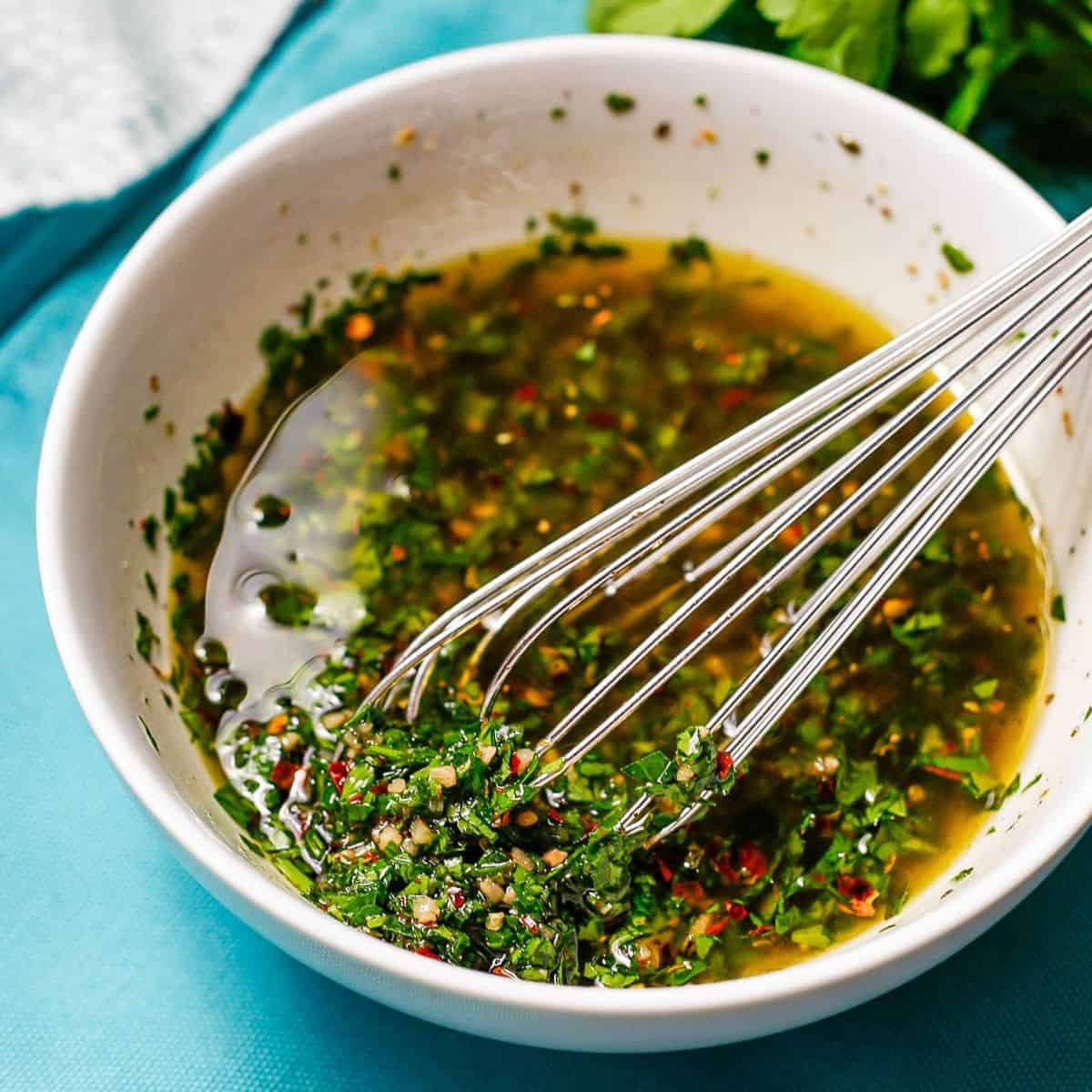This easy chimichurri recipe is a bright, fresh, herby uncooked green sauce that comes together in just minutes. Use as a marinade or to drizzle over meats and grain bowls.

You ever feel like you just need a good sauce to take a dish to the next level?
I know I do and sometimes, that is in fact exactly what’s needed.
This 5-minute homemade sweet and sour sauce is great for cooking, as is teriyaki sauce and enchilada sauce.
And don’t get me started on homemade salad dressings. Creamy cilantro lime dressing and this soy ginger dressing are two of my very faves.
(To be clear though, there's not a thing wrong with buying sauces and dressings at the store! I love a shortcut as much as the next person!)
Today, we’re going south… as in South America.
This easy chimichurri recipe is seriously yummy and it comes together in just minutes.
It’s bright and fresh and adds a big zing to meats and grain bowls. Oh, and it’s pretty gorgeous as well!

I’ve been on a roll recently with making a batch to have on hand. It’s so dang tasty.
First things first.
What is chimichurri?
- It’s an uncooked green sauce that originates from Argentina and Uruguay but that spread throughout Latin America.
It’s got a bright citrusy herby taste and adds a great punch of flavor to meats and vegetables.
It’s sort of addicting, really.
You’re gonna want to drizzle it over ALL the things!
OK, let's get cooking so you can try it too.


Now, I’ve got some notes, tips and substitutions coming up below on how to make chimichurri sauce. Just tryin’ to be helpful.
If you want to jump on down to the recipe, simply scroll right on through the rest of the text. The recipe card is near the bottom of the page, above the comments section.
Ingredient Notes:
- Olive oil: A good quality olive oil with good flavor is important to use here, since it’s the main component of the sauce.
- Parsley: Fresh parsley adds the bright green color and the big punch of citrus herby flavor. Be sure to finely chop it so it integrates well into the sauce.
- Garlic: Feel free to add an extra clove of garlic if you want to punch up the garlic flavor. Or if you aren’t a fan, reduce it to just 2 cloves.
- Vinegar: Red wine vinegar is the go-to for this sauce. You could try a white wine vinegar or apple cider vinegar, but it will slightly alter the flavor.
- Red pepper flakes: Feel free to adjust this to your desired level of heat. (As written, it’s just a bit of background heat, not at all spicy.) You can also substitute a small red chili instead of the red pepper flakes if desired. Just be sure to chop it very finely.

The recipe instructions are pretty much this: Add everything to a bowl and whisk well.
No, really. That’s it.
I have included a recommended minimum of 10-15 minutes of letting the sauce sit after you’ve made it. It helps the flavors combine.
You can also make it more in advance and store it in the fridge. You’ll just need to re-whisk it or shake it up because the oil will separate.
Also, to note, I don’t recommend blending the sauce, as tempting as that may be.
It’s not authentic, for one, and also, it makes a puree. Chimichurri is meant to be a sauce with texture and components, like the flecks of parsley and the red pepper flakes throughout.

OK, let’s talk about how to use and store your chimichurri sauce.
Recipe FAQs
Use this green sauce for marinating steak, chicken or pork. You can also use it to drizzle over cooked meats or kabobs. Or use to drizzle over grain bowls for some extra oomph. It’s even delicious on top of grilled or roasted vegetables.
Leftover sauce can be stored in a covered container in the refrigerator for up to a week. If the oil solidifies, bring the sauce to room temperature then whisk it well. You can also store it in a glass jar and just shake the sauce instead of whisking it.
Yes, this sauce freezes well! I recommend you freeze extra sauce in ice cube trays. Once frozen, pop the cubes out of the tray and transfer to a freezer-safe ziplock bag that has a label and date on it. Freeze for up to 3-4 months.
Thaw overnight in the refrigerator or add a frozen cube directly to a pan when cooking.

There you have it.
I hope you give this chimichurri recipe a try soon for a delicious new sauce you’re going to want to add to ALL the things!
Enjoy!
XO,
Kathryn
Chimichurri
Ingredients
- ½ cup extra virgin olive oil
- ½ cup finely chopped flat leaf parsley
- 3 garlic cloves, minced
- 2 tablespoons red wine vinegar
- 1 teaspoon crushed red pepper flakes
- ¾ teaspoon dried oregano
- ½ teaspoon salt
- ¼ teaspoon black pepper
Instructions
- In a small bowl, add all of the ingredients and whisk together very well.
- Let sit for at least 10-15 minutes to allow the flavors to combine, then whisk again and serve.







Leave a Reply